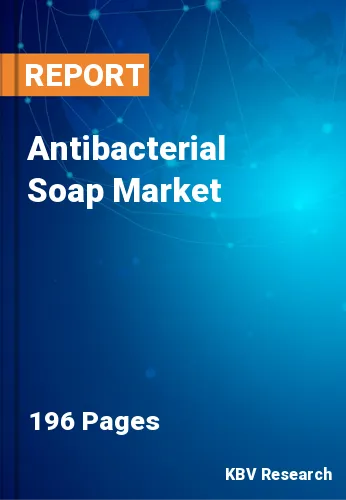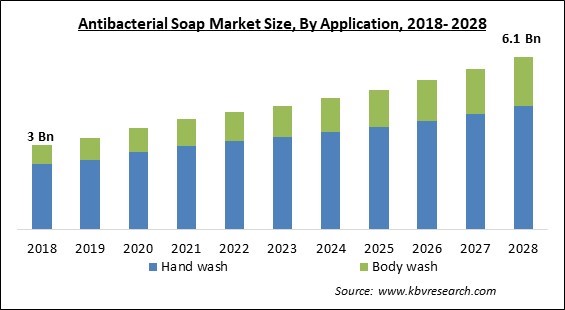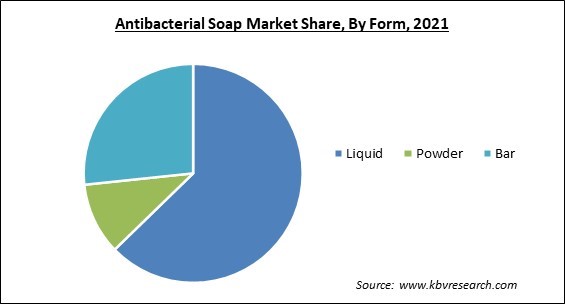
The Global Antibacterial Soap Market size is expected to reach $6.1 billion by 2028, rising at a market growth of 6.6% CAGR during the forecast period.
Antibacterial soap comprises chemical components which are supposed to aid in the destruction of bacteria. Triclosan is found in the majority of antibacterial soaps, however other chemical additions are also popular ingredients. The most frequent antibacterial ingredients in soap are triclosan and triclocarban. In addition, benzalkonium chloride, benzethonium chloride, and chloroxylenol are all typical antibacterial chemicals in soaps.
The demand for antibacterial soap is rising due to a number of factors, including increased awareness of the significance of personal hygiene and the health advantages connected with it. Contaminated hands are to blame for the majority of foodborne illnesses. Germs on hands enter the body through the mouth while eating, producing illnesses such as diarrhoea and lowering the immune system's resistance. Hand washing with soap and water can reduce diarrhoea-related fatalities by half. Furthermore, studies reveal that hand washing can avert one million fatalities per year. Additionally, by destroying germs on the body and hands, antibacterial soap can prevent respiratory disorders such as colds and flu. As per the World Bank, daily hand washing with water and soap can significantly cut healthcare costs. Due to this, the antibacterial soap market is likely to develop throughout the forecast period due to increased awareness about hygiene and cleanliness.
The antibacterial soap market is predicted to develop in the future due to manufacturers' increased focus on forming strategic alliances with leading retail chains to expand their reach and offer a wider range of customers. Reckitt-Benckiser, for example, announced a relationship with Jumia, one of Africa's major e-commerce platforms, in March 2020. This collaboration aims to provide low-cost hygiene products to Africa's people.

The COVID-19 outbreak had a beneficial impact on market growth. Antibacterial soap demand is increased as a result of panic buying and stockpiling. The government launched public awareness campaigns encouraging people to wash their hands frequently in order to eliminate the virus and restrict its spread. As the fear of becoming ill motivates homes to utilize cleaning products, Covid-19 has pushed some of the country's major packaged goods producers to bring out new hygiene and germ-protection soaps in a highly competitive area. After the outbreak of the coronavirus illness pandemic, hand washing with soap and disinfectants is inescapable as the main method of preventing infection transmission in communities & healthcare facilities.
Maintaining cleanliness is critical for reducing the onset and spread of diseases brought on by unsanitary behaviours. People can limit the spread of germs by washing infectious microorganisms off hands, utensils, and clothing. According to the World Health Organization's article "Forgetting to Wash Your Hands Can Cost Lives," published in May 2017, over 400,000 babies and 30,000 moms die each year due to diseases caused by poor sanitation and hand washing practices.
To entice customers, key players are working on developing unique solutions like fragrance-free deodorants, and clear soap scrubs. Furthermore, players are making attempts to incorporate organic and vegan components, as well as working on creating eco-friendly packaging solutions, in order to move toward sustainable products. For example, Dove, a Unilever brand, declared in October 2019 that by the end of 2020, all of its beauty bar products will be plastic-free. Moreover, businesses are taking steps to reduce their use of plastic by increasing the usage of recycled plastic and substituting plastic packaging with more environmentally friendly materials like paper and metal.
Today, triclosan can be found in a variety of places. To avoid bacterial contamination, it has been added to a variety of consumer products, including apparel, kitchenware, furniture, and toys. As a result, people's long-term exposure to triclosan is more than previously assumed, raising worries about the possible hazards of using this substance for the rest of their lives. Furthermore, laboratory investigations have raised the potential that triclosan contributes to the development of antibiotic resistance in bacteria. Antibiotic resistance may have a major impact on the effectiveness of medical therapies.

Based on Forms, the Antibacterial Soap Market is divided into Bar, Powder, and Liquid. The Bar segment garnered a significant revenue share in the antibacterial soap market in 2021. The market is growing as a certain section of consumers still prefer to use the bar form of soap, because of factors like ease to use, more comfort, and easy to carry the bar wherever the consumer want, in case consumer is in travelling mode.
Based on Application, the Antibacterial Soap Market is bifurcated into Hand Wash and Body Wash. The hand wash segment acquired the highest revenue share in the antibacterial soap market in 2021. The growth of the market is aided by increased knowledge of the health benefits of hand washing as well as antibacterial soap market demand for cleaning hands to avoid infections and ailments caused by contaminated hands.
Based on Distribution Channel, the Antibacterial Soap Market is fragmented into supermarkets and Hypermarkets, Pharmacy stores, Online Sales, and other channels. The supermarkets and hypermarket segment acquired the highest revenue share in the antibacterial soap market in 2021. The growth can be attributed to the increased penetration of independent retail behemoths like Walmart and Costco, which are improving product visibility and drawing a bigger consumer base. Furthermore, consumers like to inspect skincare goods in person before purchasing, which is driving sales via these channels.
| Report Attribute | Details |
|---|---|
| Market size value in 2021 | USD 3.6 Billion |
| Market size forecast in 2028 | USD 6.1 Billion |
| Base Year | 2021 |
| Historical Period | 2018 to 2020 |
| Forecast Period | 2022 to 2028 |
| Revenue Growth Rate | CAGR of 6.6% from 2022 to 2028 |
| Number of Pages | 196 |
| Number of Tables | 350 |
| Report coverage | Market Trends, Revenue Estimation and Forecast, Segmentation Analysis, Regional and Country Breakdown, Companies Strategic Developments, Company Profiling |
| Segments covered | Form, Application, Distribution Channel, Region |
| Country scope | US, Canada, Mexico, Germany, UK, France, Russia, Spain, Italy, China, Japan, India, South Korea, Singapore, Malaysia, Brazil, Argentina, UAE, Saudi Arabia, South Africa, Nigeria |
| Growth Drivers |
|
| Restraints |
|
Based on Region, the Antibacterial Soap Market is divided into North America, Europe, Asia-Pacific, and LAMEA. North America emerged as the leading region in the antibacterial soap market with the largest revenue share in 2021, and is expected to continue the trend over the forecast period. It is due to a number of factors, including population growth, increased health awareness, urbanization, and increased penetration of liquid antibacterial soaps, increased disposable income, improved living standards, and an increase in the prevalence of infectious diseases.
Free Valuable Insights: Global Antibacterial Soap Market size to reach USD 6.1 Billion by 2028
The market research report covers the analysis of key stake holders of the market. Key companies profiled in the report include Reckitt Benckiser Group PLC, 3M Company, Unilever PLC, Godrej Group (Godrej Consumer Products Limited), Henkel AG & Company, KGaA, Johnson & Johnson (Johnson & Johnson Services, Inc.), The Procter and Gamble Company, Amway Corporation, and Vi-Jon, Inc.
By Application
By Form
By Distribution Channel
By Geography
The global antibacterial soap market size is expected to reach $6.1 billion by 2028.
Growing awareness of personal and household hygiene are increasing are driving the market in coming years, however, triclosan and health issues growth of the market.
Reckitt Benckiser Group PLC, 3M Company, Unilever PLC, Godrej Group (Godrej Consumer Products Limited), Henkel AG & Company, KGaA, Johnson & Johnson (Johnson & Johnson Services, Inc.), The Procter and Gamble Company, Amway Corporation, and Vi-Jon, Inc.
The expected CAGR of the antibacterial soap market is 6.6% from 2022 to 2028.
The Liquid Segment acquired maximum revenue share is leading the Global Antibacterial Soap Market by Form in 2021; thereby, achieving a market value of $3.74 billion by 2028.
The North America Segment generating highest revenue share the Global Antibacterial Soap Market by Region in 2021, and would continue to be a dominant market till 2028.
Our team of dedicated experts can provide you with attractive expansion opportunities for your business.
